SUBFAMILY FORMICINAE - Genus Plagiolepis Mayr
| The Ants
of Egypt SUBFAMILY FORMICINAE - Genus Plagiolepis Mayr |
Diagnostic Features - Antennae 11-segmented. Eyes well developed and situated in the middle of the sides of the head. Ocelli usually absent. Mandibles with five teeth, clypeus large and projecting over the basal borders of mandibles. Alitrunk short, weakly constricted between pronotum and propodeum. Propodeum unarmed. Petiole a reduced scale, inclined forwards and may be overhung by the first gastral segment, never armed or emarginate. Acidopore borne on a conical projection, surrounded by a fringe of hairs. Monomorphic or polymorphic.
Mayr's (1861) genus description is at ![]() .
.
Santschi (1914e: 36) erected the subgenus Anacantholepis for
Plagiolepis in which the metanotum is very raised and distinctly
separated from a short convex propodeum (he regarded it as an
intermediate transition to the genus Lepisiota (as Acantholepis).
Santschi (1926a) clarified and restated his definitions of the Genus
and the subgenera Plagiolepis and Anacantholepis. These
are at ![]() .
.
Bolton (1995) had "Anacantholepis provisional junior synonym of Plagiolepis; Brown, 1973b: 178 (unconfirmed)". This was asserted again by Bolton (2003: 268), with the added remark that he found it impossible to resolve whether Plagiolepis and Lepisiota - "represent a single genus" or "the mass can be resolved into more than (that sic) two genera".
Bolton (2003), however, referred to Santschi's (1914c) definiton of Anacantholepis as "those species in which the metanotum, when viewed in profile, was more prominent dorsally, and the propodeum more strongly convex than was 'normal' in the genus". Bolton continued - "Both these features are marked only in the South African type species, P. (A.) decora, being less well developed elsewhere and intermediate".
Simple examination of the descriptions and illustrations reveals that the Santschi separation is very clear for several species and the subgenus appears to fully merit its status. Accordingly, I have returned to the situation prior to statements of Brown and Bolton, neither of whom appear to have given any supporting evidence or to have undertaken a review of the described species.
Salata, Borowiec & Radchenko (2018) have tried to unravel the Plagiolepis species of the east-Mediterranean and we have taken their findings into account in revising this and the linked pages,
Reference: Salata, S., Borowiec, L. & Radchenko, A.G. 2018. Description of Plagiolepis perperamus, a new species from East-Mediterranean and redescription of Plagiolepis pallescens Forel, 1889
(Hymenoptera: Formicidae). Annales Zoologici, 68 (4), 809-824.
Separation of workers - (based on Santschi, 1920g, and Emery, 1921d)
| 1 | 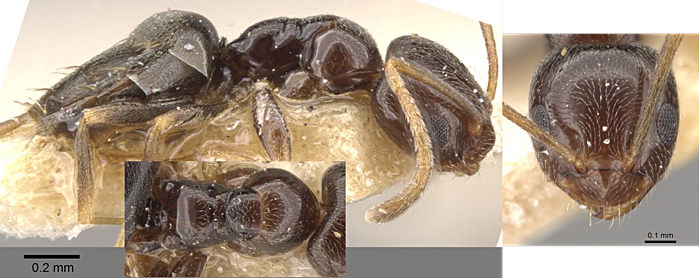 Alitrunk in dorsal view
elongated, relatively broad head, scapes surpassing occiput by ca 0.25
of own length (ensure this is in full face view); TL 2.0-2.5 Alitrunk in dorsal view
elongated, relatively broad head, scapes surpassing occiput by ca 0.25
of own length (ensure this is in full face view); TL 2.0-2.5Together with P. perperamus Salata, Borowiec & Radchenko, this has dense pubescence on the gaster dorsum. |
schmitzii |
| -- | Alitrunk in dorsal view relatively short - base
colour quite pale |
2 |
| -- | Alitrunk in dorsal view relatively short - overall colour more brown, appendages pale but dull | 3 |
| 2 | 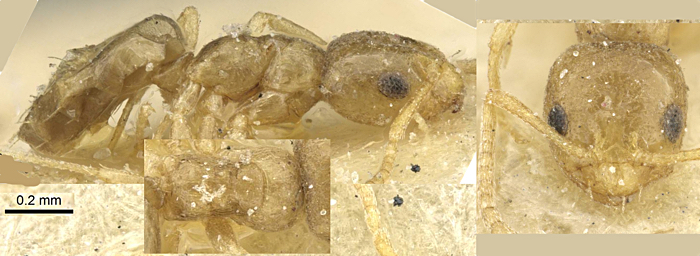 Overall colour,
especially apex of gaster, bright yellow to bright yellow-brown; isis
from Egypt a little darker, with gaster brown and somewhat silky in
appearance; eyes slightly convex; second segment of funiculus wider
than long, the third similarly wide and long, remainder of segments
longer; TL 1.6-1.7 mm Overall colour,
especially apex of gaster, bright yellow to bright yellow-brown; isis
from Egypt a little darker, with gaster brown and somewhat silky in
appearance; eyes slightly convex; second segment of funiculus wider
than long, the third similarly wide and long, remainder of segments
longer; TL 1.6-1.7 mmImage here is of isis as the type has a damaged head |
. |
| . | 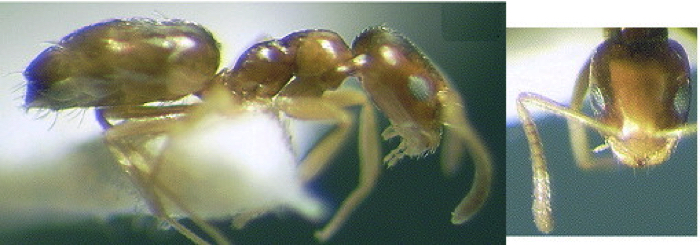 Darker form from Egypt Darker form from Egypt |
pallescens |
| -- | 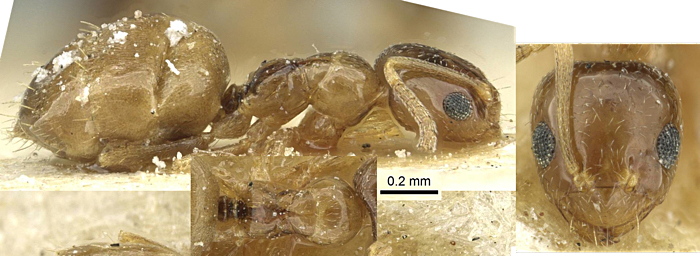 Funiculus with third and
fourth segments subequal, longer than second, about equally wide as
long, not much shorter than subsequent segments; some large hairs on
dorsum of gaster; reddish-yellow, gaster slightly brownish; TL 1.0-1.5
mm Funiculus with third and
fourth segments subequal, longer than second, about equally wide as
long, not much shorter than subsequent segments; some large hairs on
dorsum of gaster; reddish-yellow, gaster slightly brownish; TL 1.0-1.5
mm |
maura |
| 3 | 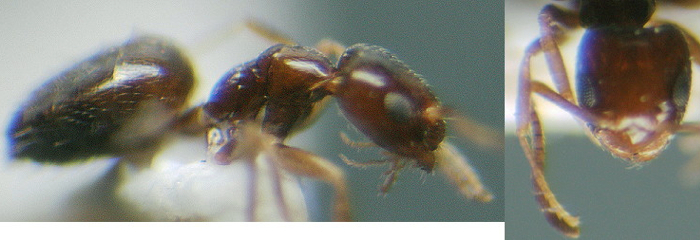 Funiculus with second and
third segments subequal, shorter than wide, much shorter than
subsequent segments; almost no pilosity on alitrunk, a few yellowish
hairs on clypeus and gaster margins, dark brown, appendages pale
ochreous; TL 1.3-2.0 mm Funiculus with second and
third segments subequal, shorter than wide, much shorter than
subsequent segments; almost no pilosity on alitrunk, a few yellowish
hairs on clypeus and gaster margins, dark brown, appendages pale
ochreous; TL 1.3-2.0 mmSalata, Borowiec & Radchenko (2018) has "3rd funicular segment quadrate or transverse, much shorter than 4th segment" |
status in Egypt dubious - pygmaea |
| -- | 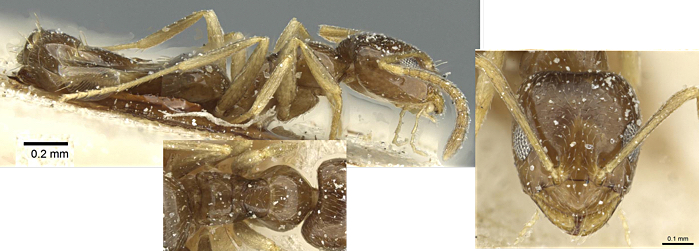 Sides of head more convex
(than maura); brown or clear brown, appendages dull
yellow-grey; erect pilosity yellow on the gaster; eyes bigger than pygmaea;
funiculus segment 2 shorter than wide, segment 3 longer but much
shorter than segment 4; clypeus very convex; TL 1.5-1.8 mm Sides of head more convex
(than maura); brown or clear brown, appendages dull
yellow-grey; erect pilosity yellow on the gaster; eyes bigger than pygmaea;
funiculus segment 2 shorter than wide, segment 3 longer but much
shorter than segment 4; clypeus very convex; TL 1.5-1.8 mmPossible junior synonym of P. pallescens (Salata, Borowiec & Radchenko, 2018) |
ancyrensis |
|
©2005, 2006, 2015, 2019 - Brian
Taylor CBiol FRSB FRES 11, Grazingfield, Wilford, Nottingham, NG11 7FN, U.K. |
href="plagiolepis.htm"